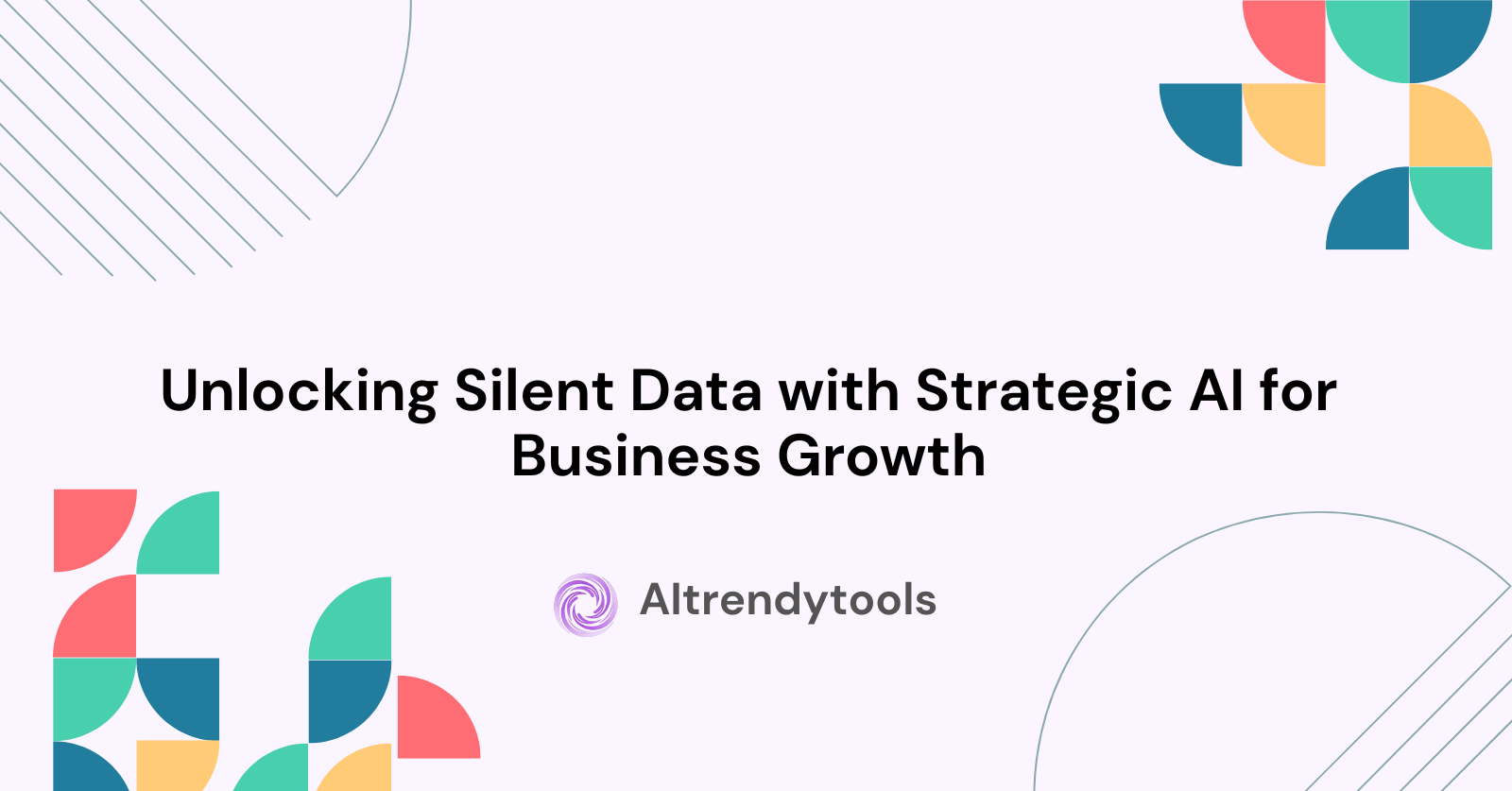🔥 AITrendytools: The Fastest-Growing AI Platform |
Write for us
Your company generates thousands of data points every day. Customer calls, sales numbers, employee feedback, supply chain updates—information flows constantly through your business. Yet many companies still feel like they're flying blind when making big decisions. What's missing? A smart approach to artificial intelligence that turns all that overwhelming data into clear, useful insights.
Here's the thing: most businesses are sitting on treasure troves of information they don't even know they have. It's not that they lack data—they lack the right tools to pull meaningful insights from all the information already flowing through their systems. AI for strategic planning changes the game completely. Instead of just reacting to what happened yesterday, companies can use AI to spot opportunities and make smarter decisions today.
The real magic happens when companies stop thinking of AI as just another tech tool. When you treat AI as a strategic partner in your planning process, it doesn't just crunch numbers faster—it finds patterns and connections that humans would never think to look for.
Understanding Silent Data: The Hidden Asset in Your Business
Silent data is all the valuable information flowing through your company that nobody's really paying attention to. Think of it like background noise that actually contains important messages—you just need the right equipment to hear them clearly.
Most companies focus on the obvious stuff: sales figures, customer demographics, and inventory numbers. But silent data lives in all the spaces between these clear-cut metrics. It includes:
- Unstructured conversations from customer service calls
- Subtle patterns in how employees work and collaborate
- Shifts in market sentiment that don't show up in traditional reports
- Complex relationships between different business processes that seem unrelated
The problem isn't collecting this information—most companies already capture it during regular business operations. The real challenge is that traditional analysis methods can't handle it properly. Old-school approaches need humans to decide what to look for before they can find anything useful. This creates huge blind spots because the best insights often come from patterns nobody thought to investigate.
Legacy systems struggle with today's data reality. They're built to answer specific questions about things you already know, but they can't spot unknown patterns or connect dots across different data sources. This means companies miss chances to improve operations, predict market changes, or understand customer needs before their competitors do.
How AI Strategic Planning Enhances Business Decision-Making
Transforming Data Into Actionable Insights
AI strategic planning transforms how organizations approach decision-making by turning raw data into strategic intelligence. Rather than simply processing information faster, AI systems can identify patterns, correlations, and trends that would be impossible for human analysts to detect manually.
The transformation begins with AI's ability to process multiple data streams simultaneously. Where traditional analysis might examine customer purchase history in isolation, AI can simultaneously analyze purchasing patterns, seasonal variations, social media sentiment, economic indicators, and competitive activity to create a comprehensive picture of market dynamics.
Forecasting Market Trends and Customer Preferences
Advanced AI models excel at predictive analysis, helping organizations anticipate market trends, customer preferences, and operational challenges before they become critical issues. This predictive capability allows companies to shift from reactive problem-solving to proactive opportunity creation. Instead of responding to market changes after they occur, businesses can position themselves to capitalize on emerging trends.
AI models can help organizations forecast market trends by analyzing historical patterns alongside current market indicators. These systems identify subtle shifts in consumer behavior, competitive positioning, and economic conditions that human analysts might overlook. The result is strategic intelligence that enables businesses to make informed decisions about product development, market expansion, and resource allocation.
Enabling Real-Time Data Analytics for Agile Decision-Making
Real-time data analytics represents another crucial advantage of AI-driven strategic planning. Traditional analysis often relies on historical data and periodic reports, creating delays between events and insights. AI systems can process information as it's generated, providing decision-makers with current intelligence that reflects the actual state of their business and market conditions.
The speed advantage goes beyond just faster processing. AI systems can continuously monitor hundreds of variables simultaneously, alerting decision-makers to significant changes or emerging patterns as they develop. This continuous monitoring creates an early warning system that helps organizations respond to opportunities and threats with unprecedented speed and precision.
Integrating AI Into Your Strategic Planning Process
Successfully implementing AI-driven strategic planning requires a systematic approach that aligns technology capabilities with business objectives. The integration process involves several critical steps that must be executed thoughtfully to maximize the value of AI investments.
Identifying Critical Data Sources for AI Analysis
The first step is mapping out all the places where valuable information lives in your company. This goes way beyond the obvious databases to include sources that might surprise you with their insights.
Start by making a list of every data source across your business. Include your CRM system, financial databases, operational logs, employee communications, and any external data feeds you use. Pay special attention to data that's sitting around unused or only gets looked at once in a while.
Here's what you should consider when evaluating each data source:
- Data quality: Is the information clean and consistent enough for AI to work with?
- Accessibility: Can you easily get the data when you need it?
- Relevance: Does this data source connect to your business goals?
- Volume: Is there enough information to train AI models effectively?
Don't forget about data sources that need some work before AI can use them. Sometimes the most valuable insights come from messy, unstructured data that just needs proper cleaning and organization.
Training AI Models to Meet Specific Business Goals
Once you know where your valuable data lives, you need to train AI models that actually help your business. This isn't about general analysis—it's about getting AI to answer the specific questions that matter to your company's success.
The key is being really clear about what you want AI to help you figure out. Instead of asking for a broad analysis, focus on precise business questions. Some examples include:
- Will this customer stop buying from us in the next six months?
- How much inventory should we stock for the holiday season?
- Which new markets should we consider expanding into?
- What operational issues are likely to cause problems next quarter?
Test your AI models using data from situations where you already know what happened. If AI can correctly identify patterns from past events, you can trust it to spot similar patterns in current data. This testing phase builds confidence in AI recommendations and shows you where the models need improvement.
The goal is to create AI that gives you insights you can actually act on. Every recommendation should connect to a decision you need to make or a problem you need to solve.
Aligning AI Outputs with Key Performance Indicators
The value of AI-driven insights depends on their connection to measurable business outcomes. Establish clear links between AI outputs and your organization's key performance indicators to ensure that AI investments translate into improved business results.
Map AI insights to specific business metrics that matter to your organization. If AI identifies patterns in customer behavior, connect those insights to metrics like customer lifetime value, retention rates, or revenue per customer. This connection helps demonstrate the business value of AI initiatives and guides future development efforts.
Create feedback loops that allow you to measure the impact of AI-driven decisions on business performance. Track how AI recommendations influence key metrics over time, and use this information to refine AI models and improve their accuracy.
Fostering Collaboration Between AI Experts and Business Leaders
Successful AI implementation requires ongoing collaboration between technical experts who understand AI capabilities and business leaders who understand strategic priorities. This collaboration ensures that AI development efforts remain focused on business value rather than technical possibilities.
Establish regular communication channels between AI teams and business stakeholders. Create opportunities for business leaders to understand AI capabilities and limitations, while ensuring that AI experts understand business priorities and constraints.
Develop shared metrics and success criteria that both technical and business teams can use to evaluate AI performance. This shared understanding helps align efforts and ensures that everyone works toward common objectives.
The Strategic Advantage of AI-Driven Planning
Companies that get AI strategy consulting right end up with serious competitive advantages. They make better decisions faster, and these advantages keep building over time. It's like compound interest for business intelligence.
AI-driven planning helps you spot opportunities that competitors completely miss. When you can analyze silent data effectively, you see emerging trends, customer needs, and market gaps before they become obvious to everyone else. Getting there first can mean capturing significant market share while others are still figuring out what's happening.
Here's what makes AI-powered strategic planning so powerful:
- Continuous learning: AI systems get smarter as they process more data and receive feedback
- Pattern recognition: Spot connections between seemingly unrelated business factors
- Speed advantage: Identifies opportunities and threats in real-time, not weeks later
- Comprehensive analysis: Considers hundreds of variables simultaneously without getting overwhelmed
The best part? AI systems improve automatically. As they process more information and get feedback on their predictions, they become better at identifying patterns and making recommendations. This creates a positive cycle where better insights lead to better decisions, which generate more data for even better insights.
Moving Forward: Your Next Steps
Adding AI to your strategic planning isn't just a tech upgrade—it's a completely different way of thinking about how you make decisions and stay competitive. Companies that make this shift successfully find themselves way better equipped to handle complexity, spot opportunities, and respond to challenges with speed and accuracy that seemed impossible before.
The journey starts with recognizing that you probably already have valuable insights hiding in your company's data streams. You don't need to generate more data—you need to get better at extracting useful intelligence from what you already have. AI gives you the tools to find these hidden insights and turn them into real competitive advantages.
Success comes down to committing to both the technology and the changes in how your organization works. The most effective AI implementations combine powerful analytical tools with cultural shifts toward data-driven decision-making and continuous learning. Companies that make this complete commitment discover that AI-driven strategic planning becomes their secret weapon in an increasingly complex business world.
🚀 Submit Your Tool to Our Comprehensive AI Tools Directory
Get your AI tool featured on our complete directory at AITrendytools and reach thousands of potential users. Select the plan that best fits your needs.





Join 30,000+ Co-Founders
Publisher
aitrendytools
Publisher
aitrendytools
Category
blogPlan
FreeRelated Tools
Essay Pro AI Detector
Check if your text is AI-generated with EssayPro's free, accurate AI Detector. Get instant results, human editing help, and keep your writing original.
Aipoemgenerator.io vs Editpad
Compare Aipoemgenerator.io vs Editpad to find the best AI poem generator. Explore features, speed, accuracy, and tech to pick the top poetry tool for you.
AI Photo Generators
Discover how AI photo generators are transforming digital marketing by enabling fast, scalable, and creative visual content like never before.
Submit Your Tool to Our Comprehensive AI Tools Directory
List your AI tool on AItrendytools and reach a growing audience of AI users and founders. Boost visibility and showcase your innovation in a curated directory of 30,000+ AI apps.





Join 30,000+ Co-Founders

